Blog Archives
August 29, 2003 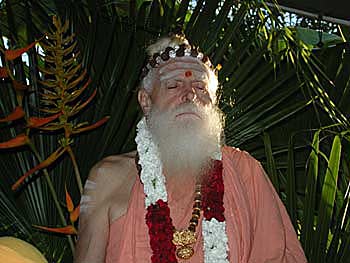
"Our soul is God Siva's emanational creation, the source of all our higher functions, including knowledge, will and love. Our soul is neither male nor female. It is that which never dies, even when its four outer sheaths-- physical, pranic, instinctive and mental--change form and perish as they naturally do. The physical body is the annamaya kosha. The pranic sheath of vitality is the pranamaya kosha. The instinctive-intellectual sheath is the manomaya kosha. The mental, or cognitive, sheath is the vijnanamaya kosha. The inmost soul body is the blissful, ever-giving-wisdom anandamaya kosha. Parashakti is the soul's superconscious mind--God Siva's mind. Parasiva is the soul's inmost core. We are not the physical body, mind or emotions. We are the immortal soul, atman. The sum of our true existence is anandamaya kosha and its essence, Parashakti and Parasiva. The Vedas expostulate, "The soul is born and unfolds in a body, with dreams and desires and the food of life. And then it is reborn in new bodies, in accordance with its former works. The quality of the soul determines its future body; earthly or airy, heavy or light." Aum Namah Sivaya."
--Gurudeva
Our Beloved and Revered Satguru Sivaya Subramuniyaswami
Attained Maha Samadhi on November 12th, 2001
Click to read for Details.
We are pleased to announce the web release of Satguru Sivaya Subramuniyaswami's monumental work on Hindu culture and lifestyle:
Living with Siva.
Click here for the entire text and artwork, now on-line!
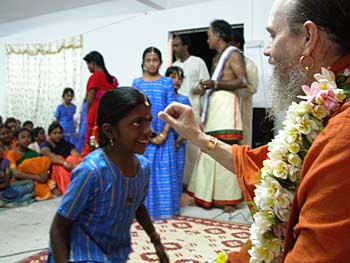
We have no news or pictures from the 29th in Mauritius. The team there is very busy now moving from home to home, meeting with the extended families of our mission across the island. We do have some more news from last evening's event at the temple and also from events in California on the 23rd. Sadhaka Jivanandanatha writes:
"We had a wonderful event last night at a small yet powerful temple with extremely devotional devotees. Their love shined through their beautiful smiles."
Bodhinatha's Sun One Video. Most Recent update: July 30, 2003. Bodhinatha speaks on Japa, Mantra Repetition, niyama # 9, elucidating the many dimensions of the sacred science of mantrams, chanting a holy syllable, word or sentence again and again. 14 minutes, 2 seconds
 |
|
|
|
Live Web Cam Pix! |
 |
||||
We were greeted by a line of stick dancers who lead the parade around the temple, while everyone sang guru bhajans. We then attended the puja. This temple is a Siva temple with both Ganesha and Muruga on either side. The puja was similar to ours. Near the end of the puja, the priest would chant 1 line and all the devotees would chant the next. With a huge number of children this was a thundering response. We then proceeded to a short dance to Lord Ganesha by some young girls (pictured here).
We then adjourned upstairs for Bodhinatha's talk. He talked about the four sects of Hinduism and about Siva. His key line was to "think of Lord Siva as your mother and father."
There was about 150 people there, about 80 percent of the crowd was women and children, with lots of children. Toward the end everyone came up to Bodhinatha for blessing.
It was very well received and was translated into Creole by Rajen Manick.
The children were especially charming with genuine smiles.
That's all for now. Today we are off to members homes.
Aum Shanti,
Sadhaka Jivanandanatha and the traveling team
![]()
Saiva Siddhanta Church
Golden Gate Mission
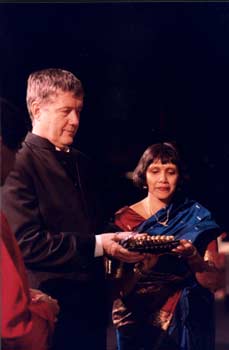
Bodhinatha presided over the Arangetram of Venita Katir in Fremont on August 23rd. On that night he also gave a short but powerful and clear talk, the transcript of which you may find below. Here now are photos and captions from Kulapati Easan Katir, Venita's father.
~~~~~~~~~~~~~~~
Golden Gate Mission member Taruni Venita Katir
performed her Arangetram Saturday in California. Before the performance,
her parents blessed her chalangai during puja.
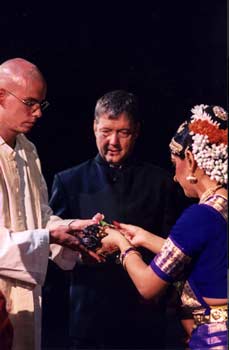
The pujari, Sadhaka Jivanandanatha, began the evening with a beautiful puja, and after blessings returned the chalangai to the dancer.
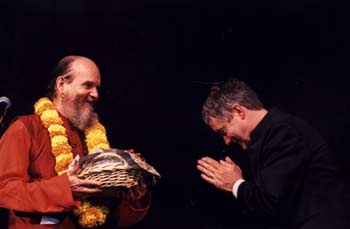
Kulapati offers the traditional dakshina to the Chief
Guest of Honor.
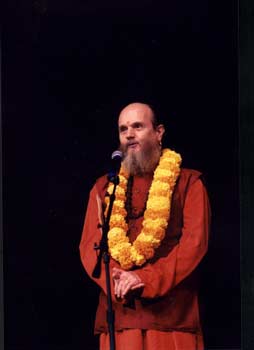
Chief Guest Satguru Bodhinatha drew four corollaries between the discipline of dance and the discipline of sadhana on the Hindu path. First, focus on improving weak parts, the strong parts take care of themselves; second, the attitude of continual improvement; third, learning from mistakes and not repeating them; and fourth, both are paths beyond intellect. "Both come from practice, lots of practice."
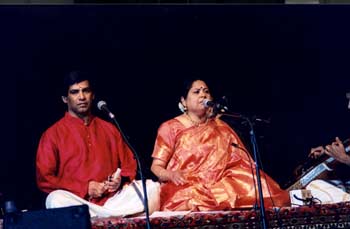
The natunar, Sri Prakash Yadagudde, and the vocalist, Smt. Sivasakti Sivanesan, each artistic directors of the London Bharata Vidya Bhavan for the past 20 years. Also part of the orchestra not shown: Bhavani Shankar, mrdungam, Raja Sivamani, veena, and Ragavan Maniam, flute.
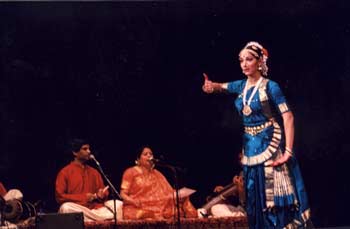
Venita as the child Muruga holding his Vel in
Chinna Vayadinelai..
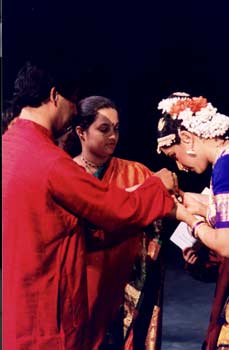
Venita's teacher, Sri Prakash Yadagudde, and his
wife, Rama blessing the chalangai.
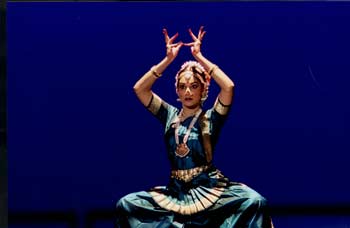
Lord Siva's kundalini opening the saraswara
chakra in Bho Shambo
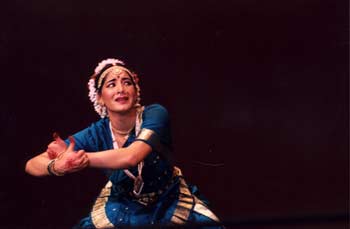
As Markendaya clinging to the Sivalinga while
Yama tries to take him away. Siva appears, chases Yama away, and grants
Markendaya a long life.
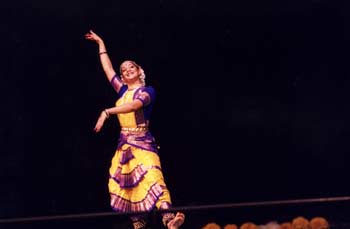
As Dancing Ganesha in the pushpanjali.

One of Lord Siva's 108 Tandavas in Devi Neyai Thunai.
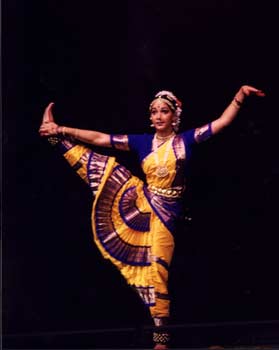
Another difficult Tandava pose.
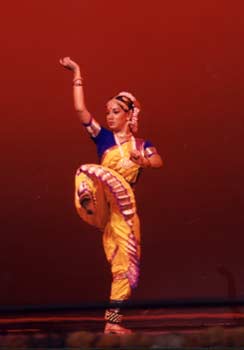
Proud invincible Madurai Meenakshi Devi riding a horse with lasso in battle. Later, when she sees Siva, her ego vanishes, and Siva and Devi marry.
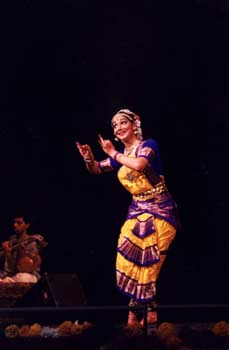
A Devi playing the flute, Goddess of the fine arts.
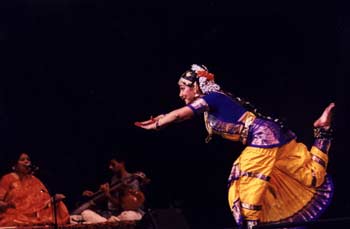
Describing Madurai Meenakshi Devi. Imitating a fish, to
convey that Devi has fish-shaped eyes.
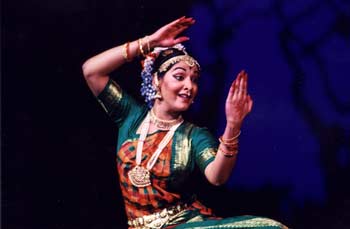
The acts of a devotee preparing to visit the temple in the early morning. Here she looks in the mirror and applies a pottu during the Natakuranji Varnam
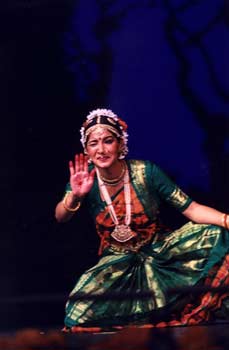
During the Varnam, Venita portrayed the story of St. Kannapan. Here St. Kannapan Nayamar donates his recently plucked right eye to Siva. So complete is his devotion to God, he is williing to be blind to the world.

Here we are with photos back on Kauai. This past retreat was the monthly silpi outing and they were taken up to Kokee National Park. Fortunately it was a clear day, offering an incredible view of the famed Waimea Canyon.
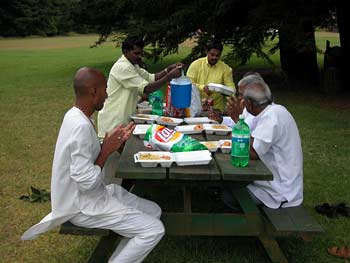
Picnic with the silpis... Kumar provides a lovely lunch of Vadai, and various curries and chutney.
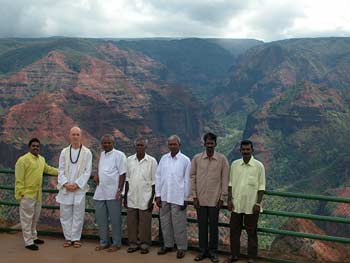
The silpis were amazed by the view and reported, on returning home "We have never seen anything like that in all our lives!"
No Audio Today
|
Be surprised! Take this opportunity for an adventure. Close your eyes and click to get a message picked at random from the vast audio archives of our Satgurus' discourses |
And click here for an Index to All Past CyberTalks.
|
| FULL INDEX OF 650+ CYBERTALKS
 |
|
Study Gurudeva's teachings.
|
transcription begins
Date: August 23, 2003
Title: Four Attitudes for Striving in Dance And Spiritual Life
Category: The Spiritual Path
Duration:
Date Given: August 23, 2003
Given by: Bodhinatha
Our talk this afternoon is on the subject of four ways the attitudes involved in studying Bharata Natyam and the attitudes involved in striving to make progress on the Hindu spiritual path are indeed the same.
Strengths and Weaknesses
Our first comparison of the spiritual path to the study of Bharata Natyam is the attitude toward strengths and weaknesses. Does a young women become a better dancer by focusing on the movements she does well? Of course not. She has to focus on the movements she does not do well and strive to improve them. Said another way, she becomes a better dancer not by focusing on her strengthens but rather her weaknesses.
Looking at the spiritual path, let us take the example of someone who is happy to help coordinate activities at a nearby Hindu center however when she attends puja doesn't really feel much devotion for the Deity. Her strength is service and her weakness is devotion. Therefore, to further advance she needs to focus less on service and more on activities that will help her deepen devotion such as learning and singing bhajans, growing flowers in the home garden for the temple and sewing clothes for the Deity.
Continue to Improve
A second comparison is the attitude toward improvement. A good dancer has the attitude that she can always perform a dance better than she has done it before. She feels there is always room for improvement, that her movements can always be even further refined.
Looking at the spiritual path, let us take as our example the principle of ahimsa, nonviolence in thought, word and deed. It is indeed a central principle of Hinduism. Of course, most of us do not indulgence in physical violence. Therefore, we may conclude that ahimsa presents no challenge to us.
However, let's look more closely at the definition of ahimsa which is not harming others by thought , word or deed. This points out that even though we are not harming others with our actions, we can take the attitude of striving to improve our behavior even more by carefully watching our speech and avoiding harming others through our words. The common forms of verbal violence are joking, teasing, gossiping and backbiting and every reduction we make in lessening harming others through our words produces spiritual progress.
Learning from our Mistakes
A third comparison of the spiritual path to the study of Bharata Natyam is our attitude toward mistakes. I am sure many dancers when they first start are very self-conscious about their mistakes. They make a mistake and get flustered and can't really concentrate on the rest of the dance class. A good teacher will encourage them and point out mistakes are natural, all dance students make them. Because of the teacher's encouragement we soon get over being self conscious of our mistakes and take on a more positive attitude which is if we make a mistake in a dance movement, next time we will try our best to do the movement better.
For all of mankind, no matter where one is on the path, spiritual advancement comes from learning from one's mistakes in life. Unfortunately, this process is often inhibited by the idea that somehow we are not supposed to make mistakes. A common first reaction to having made a mistake is to become upset that we made the mistake, get emotional about it, or if it is a serious mistake to become quite burdened and even depressed. However, we need to be like the dancer and simply resolve to do better next time. Thus a good second reaction to a mistake is to think clearly about what happened and why the mistake occurred and find a way to not repeat the mistake in the future. Perhaps we were not being careful enough, and resolving to be more careful next time will prevent the problem from occurring. Perhaps we did not know something, and now we have that knowledge and can simply resolve to use that knowledge next time.
Nonintellectual
A fourth and final comparison is that they are both nonintellectual. You do not become a good dancer through reading a book. Though some reading is involved, the main focus is on the actual practice of dancing. Our physical body is significantly changed and gains new abilities through the many years of dance practice.
Reading spiritual books is certainly part of making progress on the spiritual path. However much more important is the regular practice of spiritual disciplines. Our emotional, intellectual and spiritual natures are all significantly changed through performing spiritual disciplines for a period of many years.
Hinduism's spiritual practices can be divided into four categories: good conduct, service, devotion and meditation.
Good conduct is the foundation of all other practices in Hinduism. It begins with overcoming basic instinctive patterns such as the tendencies to become angry and hurtful. A helpful list of these tendencies is contained in the ten classical restraints called yamas. Observing the yamas naturally leads into a second set of practices which are called the niyamas and are of the nature of religious observances. Good conduct also includes performing one's duty to family and community, honoring holy men, respecting elders and atoning for misdeeds.
Service is also called karma yoga or seva and refers to religious service given without the least thought of reward, which has the magical effect of softening the ego and bringing forth the soul's innate devotion.
Devotion is also called bhakti yoga and centers around regularly worshipping the Deity at the temple and inwardly striving to awaken a profound love of God in our hearts, soften our intellect and develop a deep sense of humility.
Meditation is also called raja yoga or ashtanga yoga as it consists of eight limbs. Meditation begins with asana--sitting quietly in yogic posture--and pranayama, breath control. Pratyahara, sense withdrawal, brings awareness into dharana, concentration, then into dhyana, meditation. Dhyana finally leads to samadhi, God Realization.
Conclusion
In conclusion, today we have looked at four ways in which the attitudes of mastering Bharata Natyam and making significant progress on the spiritual path are identical. They both require focusing on our weaknesses and improving them, an attitude that we can always make further improvements and refinements in our actions, striving to learn the full lesson from each mistake in order not to repeat it and finally that progress in both dance and on the spiritual path comes from practice, lots of practice.
transcription ends
|
MORE UPLIFTING THINGS |
2004 Indian Odyssey
Join Satguru Bodhinatha Veylanswami on an 18 day Innersearch to South India, from Jan 19 to Feb 5, as we pilgrimage to ancient monasteries, magnificent 1,000 plus year old sacred temples and meet with India's holy men in a life-transforming adventure. Click on the above link for more details. |
|

|
Check our children and youth section for new items for the young and young at heart! | |
|
1. SIGN OUR GUESTBOOK and receive a FREE GIFT |
||
| 2. Newest Book: LIVING WITH SIVA | ||
|
3. Visiting KAUAI'S HINDU MONASTERY |
||
|
4. Contribute to THANK YOU, GURUDEVA FUND |
||